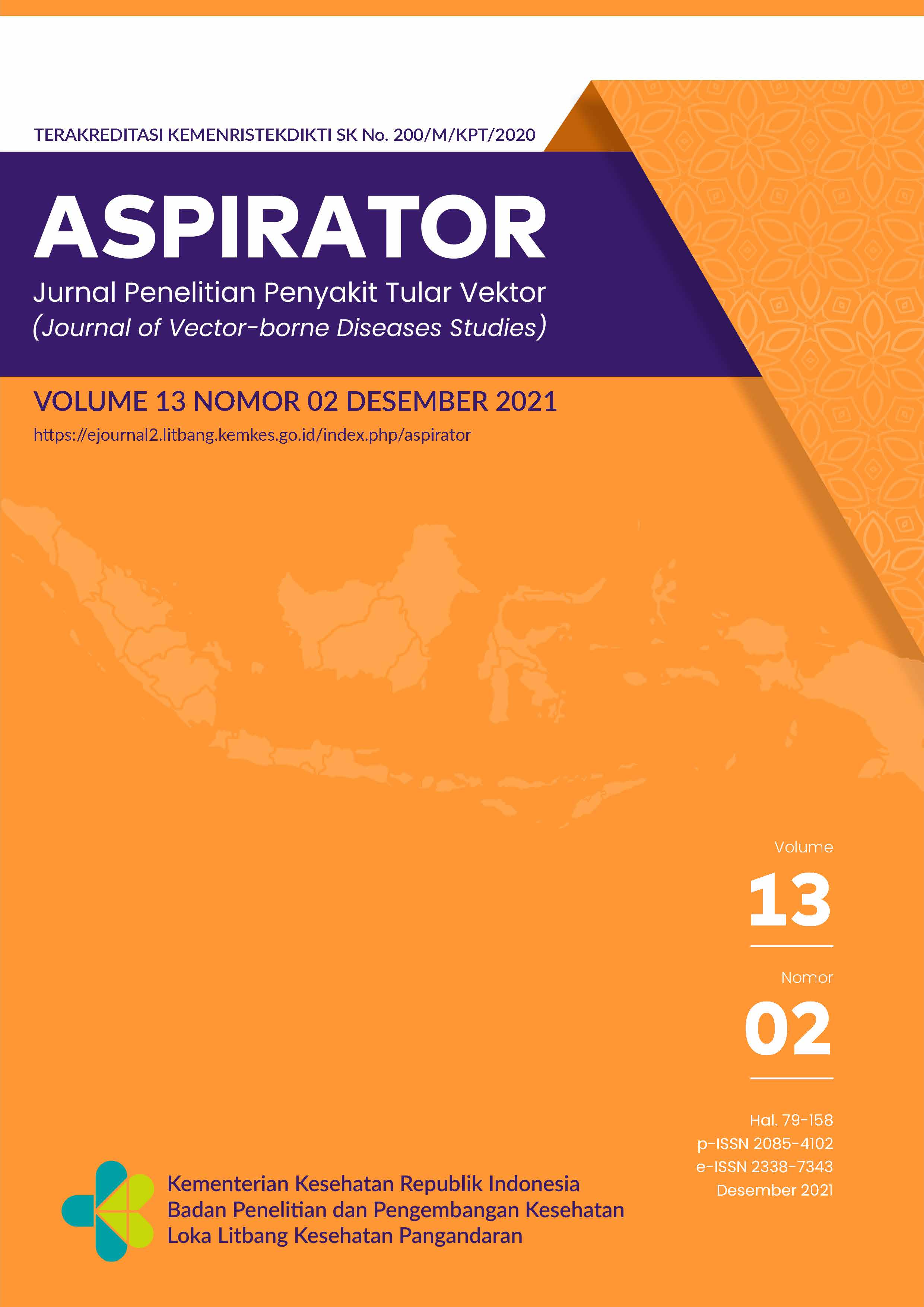Analisis Indikator Entomologi dan Sebaran Jentik Aedes aegypti pada Daerah Stratifi kasi Endemisitas Demam Berdarah Dengue di Kota Jayapura
Analysis of Entomology Indicator and distribution of Aedes aegypti vector based on stratifi ed Endemicity Areas of Dengue Hemorrhagic Fever (DHF) in Jayapura City
Abstract
The incidence rate (IR) of Dengue Hemorrhagic Fever in Papua Province in 2017 was
8.04 per 100,000 population, with a case fatality rate (CFR) of 1.12%. In 2016, the Health Offi ce of
Jayapura City declared six urban villages as high endemic areas, four urban villages as high sporadic
areas, and ten villages as DHF-free areas from a total of 39 urban villages in Jayapura. This study
aims to analyze larval by House index [HI], Container index [CI], Breateu index (BI), and Maya index
[MI] as well as the distribution of vector Ae. aegypti in endemic, sporadic and DHF-free areas in
Jayapura City. The design of this study was a cross-sectional study. This research was conducted from
January to March 2019. Subjects (375 houses) were surveyed according to WHO guidelines based
on its endemicity stratifi cation. Observations of mosquitos’ larvae were done using visual and single
larvae methods. The result of this research showed that endemic areas had their HI, CI and BI as much
as 43.3%, 16.5%, and 90.0%, respectively, with density fi gure is six. Sporadic areas had their HI,
CI and BI as much as 35.4%, 10.9%, and 57.5%, respectively, with density fi gure is fi ve. DHF-free
areas had their HI, CI, and BI as much as 14.8%, 5.7%, and 35.2%, respectively, with density fi gure
is fi ve. The Maya index for endemic and sporadic areas was categorized as moderate, while DHF-free
areas were low.
References
2. Kementerian Kesehatan Republik Indonesia. Profi l Kesehatan Indonesia 2019. Ministry of Health of the Republic of Indonesia: Jakarta, 2020.
3. Dinas Kesehatan Kota Jayapura. Profi l Dinas Kesehatan Kota Jayapura Tahun 2016. Jayapura, 2016.
4. Prasetyowati H, Ginanjar A. Maya indeks dan kepadatan larva Aedes aegypti di daerah endemis DBD Jakarta Timur. Vektora 2017; 9: 43–49.
5. Endang P, Heni P, Ginanjar A. Risiko Penularan Demam Berdarah Dengue berdasarkan Maya Indeks dan Indeks Entomologi di Kota Tangerang Selatan, Banten. 2016:26(4); 211-218. htt p://dx.doi.org/10.22435/mpk. v26i4.4510.211-218. Media Litbangkes.
6. Murni M, Nelfi ta N, Risti R, Mustafa H, Maksud M. Indeks Maya dan Indeks Entomologi Vektor Demam Berdarah Dengue di Kabupaten Mamuju Tengah, Sulawesi Barat. Balaba J Litbang Pengendali Penyakit Bersumber Binatang Banjarnegara 2020; 16: 189–98.
7. Azzahra F, Rosa E, Irianto M, Mutiara H. Penentuan Status Maya Index Larva Aedes Sp. J Penelit Perawat Prof 2020; 2: 15–24.
8. Fardhiasih D, Susanti A. Perbedaan Indeks entomologi pemantauan jumantik dewasa dan jumantik anak di Dusun Mejing Kidul, Ambarketawang, Gamping, Sleman, Yogyakarta. J Vektor Penyakit 2017; 11: 33–42.
9. Service M. Mosquito ecology fi eld sampling methods. Chapman and Hall, 2008.
10. World Health Organization. Entomological surveillance for Aedes spp. in the context of Zika virus: Interim guidance for entomologists. WHO Press: Geneva, 2016.
11. Halstead S. Community-based dengue control? a description and critique the rockefeller foundation program. Trop Med 1994; 35: 285–91.
12. Danis-Lozano R, Rodríguez MH, Hernández-Avila M. Gender-related family head schooling and Aedes aegypti larval breeding risk in Southern Mexico. Salud Publica Mex 2002; 44: 237–242.
13. Taslisia T, Rusjdi SR, Hasmiwati. Survei entomologi, maya index, dan status kerentanan larva nyamuk Aedes aegypti terhadap temephos. J Kes Andalas 2018; 7: 33–41.
14. Nisha R, Saravanabavan V, Balaji D. Knowledge, att itude and practice in dengue endemic areas in Madurai District. Int J Contemp Med Res 2020; 7.
15. Telle O, Nikolay B, Kumar V, Benkimoun S, Pal R, Nagpal B et al. Social and environmental risk factors for dengue in Delhi city: A retrospective study. PLoS Negl Trop Dis 2021; 15: e0009024.
16. Nofi ta E, Hasmiwati, Rusdji SR, Irawati N. Analysis of indicator entomology Aedes aegypti in endemic areas of dengue fever in padang west sumatera indonesia. Int J Mosq Res 2017; 2: 57–9.
17. Dhewantara PW, Dinata A. Analisis Risiko Dengue Berbasis Maya Index pada Rumah Penderita DBD di Kota Banjar Tahun 2012. Balaba J Litbang Pengendali Penyakit Bersumber Binatang Banjarnegara 2015; 11: 1–8.
18. Ben AW, Amraoui F, M’Ghirbi Y, Schaff ner F, Rhaim A, Failloux A et al. A Survey of Aedes (Diptera: Culicidae) Mosquitoes in Tunisia and the Potential Role of Aedes detritus and Aedes caspius in the Transmission of Zika Virus. J Med Entomol 2019; 56: 13–77–1383.
19. Harapan H, Rajamoorthy Y, Anwar S, Bustamam A, Radiansyah A, Angraini P et al. Knowledge, att itude, and practice regarding dengue virus infection among inhabitants of Aceh, Indonesia: a cross-sectional study. BMC Infect Dis 2018; 18:1–6.











